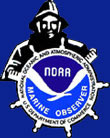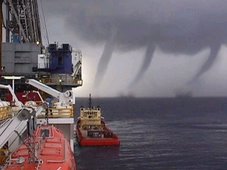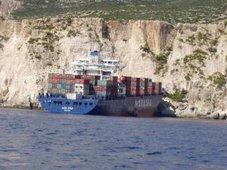 Let's take a look at some technology that is critical to both the oceanography and salvage fields. They are known as Remote Operated Vehicles (ROVs).
Let's take a look at some technology that is critical to both the oceanography and salvage fields. They are known as Remote Operated Vehicles (ROVs).Remotely operated underwater vehicles (ROVs) are unoccupied, highly maneuverable underwater robots operated by a person aboard a surface vessel.
They are linked to the ship by a group of cables that carry electrical signals back and forth between the operator and the vehicle. Most are equipped with at least a video camera and lights. Additional equipment is commonly added to expand the vehicle’s capabilities. These may include a still camera, a manipulator or cutting arm, water samplers, and instruments that measure water clarity, light penetration, and temperature. First developed for industrial purposes, such as internal and external inspections of pipelines and the structural testing of offshore platforms, ROVs are now used for many applications, many of them scientific. They have proven extremely valuable in ocean exploration, and are also used for educational programs at aquaria and to link to scientific expeditions live via the internet.
Deployment and Maneuverability
ROVs range in size from that of a bread box to a small truck. Deployment and recovery operations range from simply dropping the ROV over the side of a small boat to complex deck operations involving large winches for lifting and A-frames to swing the ROV back onto the deck. Some even have “garages” that are lowered to the bottom. The cabled ROV then leaves the garage to explore, returning when the mission is completed. In most cases, however, ROV operations are simpler and safer to conduct than any type of occupied-submersible or diving operation.

Lights and video cameras equip ROVs, enabling the operator to record imagery below the ocean surface. The S2 Phantom ROV, shown here, can move horizontally, vertically and laterally. Click image for larger view.
The disadvantages of using an ROV include the fact that the human presence is lost, making visual surveys and evaluations more difficult, and the lack of freedom from the surface due to the ROV’s cabled connection to the ship. The S2 Phantom ROV highlighted here has been rated to an operating depth of 2,400 ft. The vehicle has four thrusters that each provide one-half horsepower of thrust for horizontal, lateral, or vertical movement. Two of the thrusters are mounted horizontally. They allow the vehicle to move forward and backward, and to turn left and right. The other two thrusters are mounted at an angle, slanted in opposite directions. They provide vertical thrust (when both spin in the same direction) and lateral thrust (when they spin in opposing directions, one pushing water up, the other pushing it down).
An ROV operator controls the vehicle from a system on board the ship. Using a joystick, a camera control, and a video monitor, the operator moves the vehicle and the camera to desired locations; the operator’s eyes essentially “become” the camera lens. The vehicle’s depth, heading, and geographic position (latitude and longitude) are also recorded.
Multiple UsesROVs are often kept aboard vessels mounting submersible operations for several reasons; the first is safety. In the event that a submersible becomes entangled or otherwise incapacitated, an ROV can investigate the scene to help the operators decide how to respond. If appropriate, cutter blades can be attached to the manipulator arm and used to free the sub. If a sub loses power and cannot surface, the ROV’s manipulator arm can grab onto the sub. The deck crew can then bring the sub to the surface.
ROVs also support exploration and science objectives. When the submersible cannot be used because of weather or maintenance problems, the ROV often can take its place. It can also be used to investigate questionable dive sites before a sub is deployed, limiting risk to the expensive subs and their pilots.
Lets take a look at a salavge application.
The Wreck of the Bow Mariner
Information about the tragic explosion and sinking of the Bow Mariner
Feb. 28, 2004
| click on photos to see the full size image | photos courtesy of NOAA |
| click to enlarge |
On Saturday, February 28, 2004 the Bow Mariner, a 570 foot tanker was southbound off the coast of Virginia when it caught fire, exploded and sank. The tanker was carrying 3.5 million gallons of ethanol, 48,000 gallons of stored diesel fuel and 193,000 gallons of fuel oil. The vessel was roughly 50 miles east of Chincoteague, Virginia in about 240 feet of water when it sank. Water temperature was around 44 degrees at the time.
A scallop boat Captain described the disaster:
"I was 30 miles north of the Bow Mariner when she blew. I heard the MayDay(s) and about 20 seconds later all the other trawler skippers say "Look at that! The flames are several hundred feet." then the explosion and the flames were several thousand feet." Another scalloper described it this way..."The sun was setting in the west and from the flames on the Bow Mariner it looked like another sun was rising in the east."
Six survivors and 3 bodies were initially recovered from the water. The Coast Guard suspended the search for the 18 missing crewmembers from the Bow Mariner at 1 p.m. March 1, 2004. The search had involved more than 80 Coast Guardsmen, including crews from Station Chincoteague, Va., Air Station Atlantic City, N.J., and Elizabeth City, N.C., the 87-foot patrol boats Shearwater and Albacore from Hampton Roads, Va., and six command centers. Crews conducted 30 separate search patterns expending more than 3,500 man hours and covering an area of approximately 70 square miles.
Reports from the various government agencies as well as local witnesses described the ethanol to be dissipated and the oil slick to be about 9 miles in length off the coast within days. Favorable weather helped disburse the oil and carry it offshore. The Marine Spill Response Corporation (MSRC) oil recovery vessel Virginia Responder was dispatched on the scene and recovered approximately 25,000 gallons of an oily water mix about 18 miles from where the vessel sank.
The USCG cooperated with NOAA on the disaster and the NOAA Ship Rude was brought in to survey the wreck with side scan sonar technology. In addition SMIT Salvage was contracted to explore the wreck further and possibly extract chemicals from the vessel.
The ROV (ROLS)
FRAMO Remote Offloading System
Salvage work began in the case of the tanker BOW MARINER, on Feb.28 after experiencing several explosions and fire. Six crewmen survived, 3 bodies have been recovered and 18 are missing.
The salvage team deployed a Remotely Operated Vehicle (ROV) and specialized divers to locate the missing crewmembers of this tragic accident. The salvor's second task was to remove the bunker oil from the tanker that lies in the Atlantic Ocean at a depth of approximately 264 feet.
Heavy weather has hampered ROV operations to locate the missing seamen as well as survey operations to determine whether recoverable quantities of its cargo of ethanol or bunker fuel remain in the vessel. The salvage team used a unique pollution recovery system, the FRAMO Remote offloading System (ROLS) that has been designed to remove oil and chemicals from vessels lying on the seabed in very deep water without the assistance of divers.
This ROV reverse screws itself in the side of the ship board tanks and drills a 3/8" dia hole, inserts its impeller into the ships tanks and then begins to pump the bunkers to a waiting ship or barge on the surface.Next we will take a look at other specific ROVs and there missions.
Maritime Notes:
Other marine casualities due to storms. from Cargolaw
90-m 3,183-gt Cyrpus-flagged cargo M/V Storoe (IMO 9321530) lost several hundred logs in the North Sea off Juist in rough seas on Sept. 9. Warnings for navigational hazards have been issued. From our Sr. Correspondent Tim Schwabedissen (Wed. Sept. 12 2007)
Spanish F/V Nueva Pepita Aurora, with 16 men aboard, sank amidst strong winds in the waters off the town of Tarifa, southern coast of Spain, on Sept. 5. Three people reported dead and five others missing. (Thurs. Sept. 6 2007).
Weather Story: UPDATE 13.08.2007

HURRICANE HUMBERTO woke up the Southern Texas Coast!
Sept. 13 (Bloomberg) -- Humberto, the third hurricane of the Atlantic season, slammed into eastern Texas early today with winds of 85 miles (135 kilometers) an hour.
Humberto hit the Texas coast east of High Island at about 2 a.m. local time, the U.S. National Hurricane Center said on its Web site. At 7 a.m., Humberto was about 25 miles west-northwest of Lake Charles, Louisiana, on the Texas-Louisiana state line, heading northeast at 12 mph. Sustained winds weakened to 80 mph.
The system grew to a hurricane less than 24 hours after developing into a tropical depression. It is expected to weaken to a tropical storm over land.
Forecasters are also monitoring a system about 930 miles east of the Lesser Antilles with sustained winds of about 35 mph. The depression in the Atlantic may develop into a tropical storm today, the center said in a separate advisory.
Humberto prompted the center to issue a hurricane warning from east of High Island to Cameron, Louisiana. The area includes three major oil refineries around Port Arthur and Beaumont in Texas. Texas Governor Rick Perry put National Guard forces, helicopters and vehicles on standby for search-and-rescue operations as Humberto intensified from a depression to a storm. A state of emergency was declared yesterday in Louisiana.
``Some areas of our state remain saturated by summer floods, and many communities in this storm's projected path are at high risk of dangerous flash flooding,'' Perry said on his Web site. ``We will work with local officials to provide the state resources necessary to ensure the safety of all Texas residents as this storm moves over.''
Plants in Area
The warning area for Humberto encompasses a Total SA plant producing 240,000 barrels of oil a day, Valero Energy Corp.'s 325,000 barrel-a-day facility and the 285,000 barrel-a-day Motiva Enterprises LLC plant. Motiva is a refining joint venture between Royal Dutch Shell Plc and Saudi Aramco.
Humberto's sustained winds of 85 mph made the system a Category 1 hurricane, the weakest on the five-step Saffir-Simpson scale. Hurricane-force winds extended 15 miles from the eye of the storm, and tropical storm-force winds of at least 39 mph reached out 60 miles.
The system was forecast to dump as much as 15 inches (38 centimeters) of rain on a track from southwestern to northeastern Louisiana, southeastern Arkansas and into central and northern Mississippi.
``Isolated tornadoes are possible in southeastern Texas and southwestern Louisiana through this afternoon,'' the hurricane center said.
To contact the reporter on this story: Alex Morales in London at amorales2@bloomberg.net .
Last Updated: September 13, 2007 08:22 EDTRS





































































































![Validate my RSS feed [Valid RSS]](valid-rss.png)